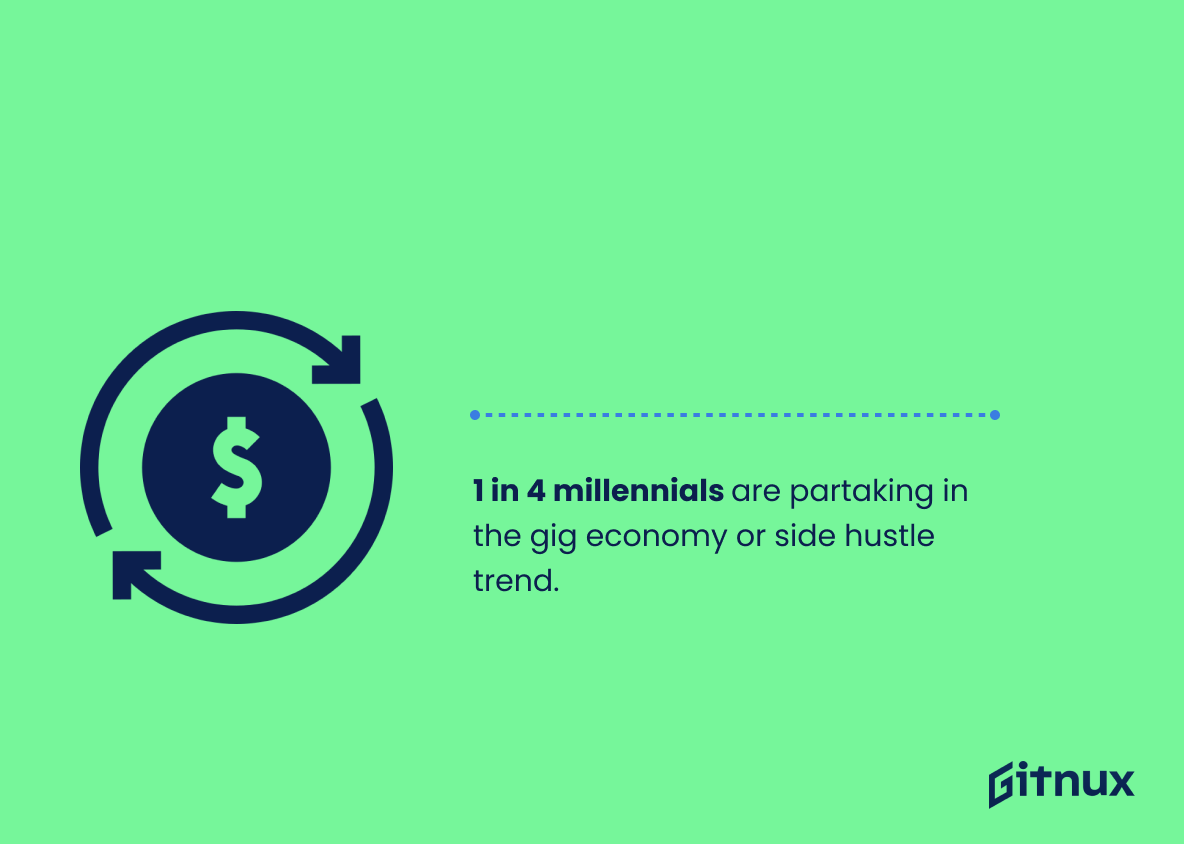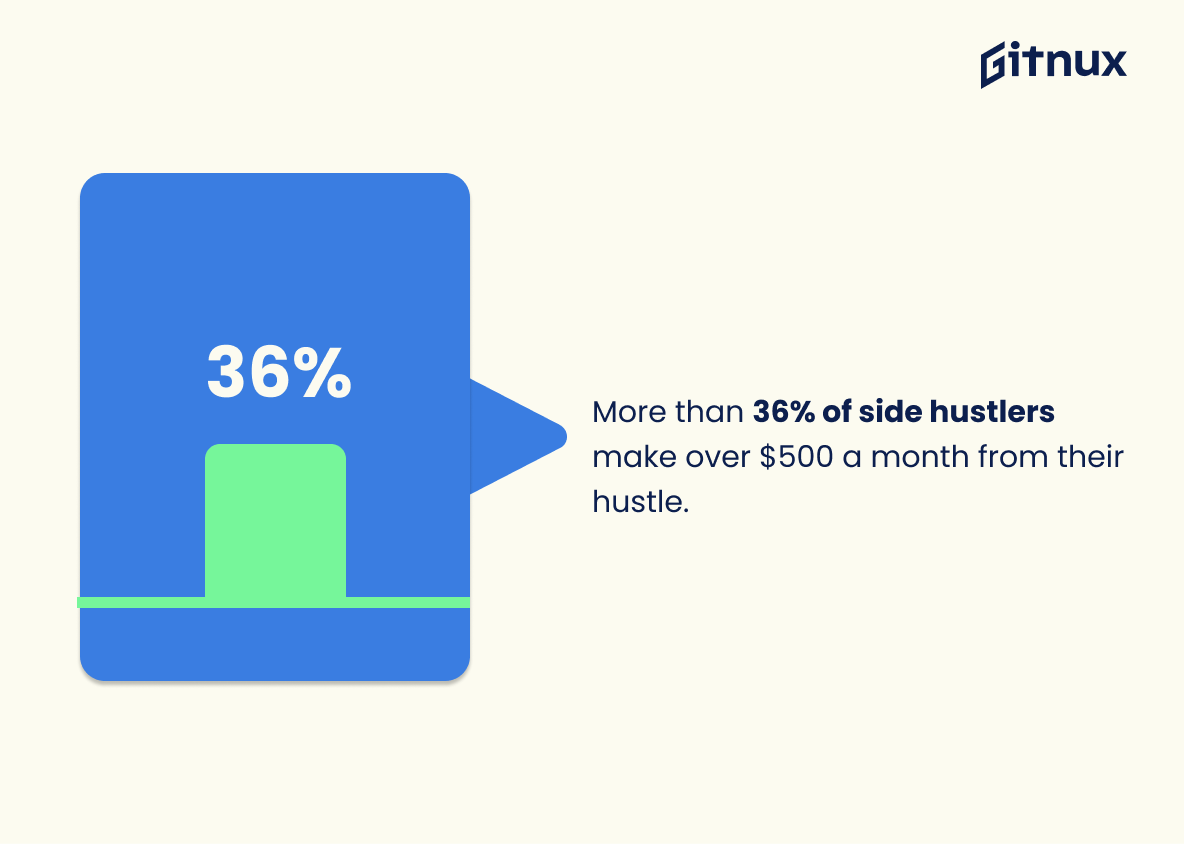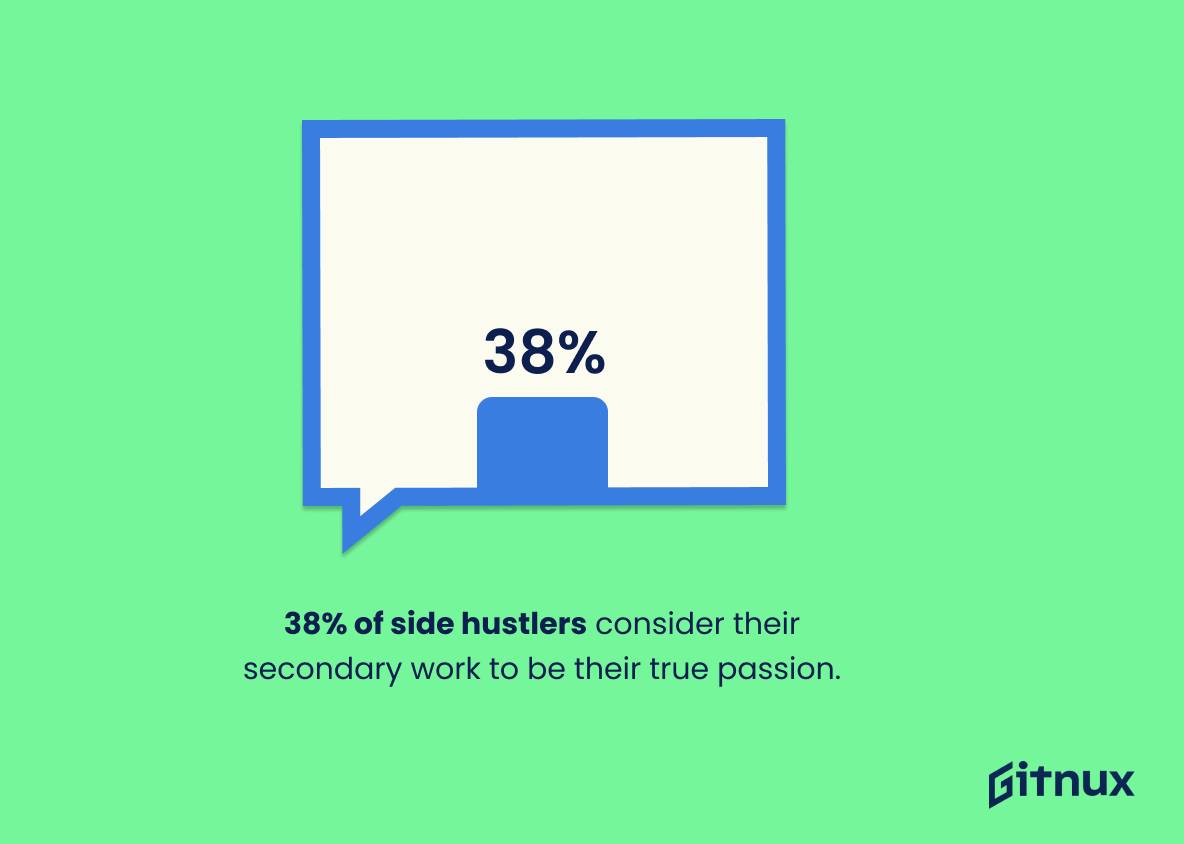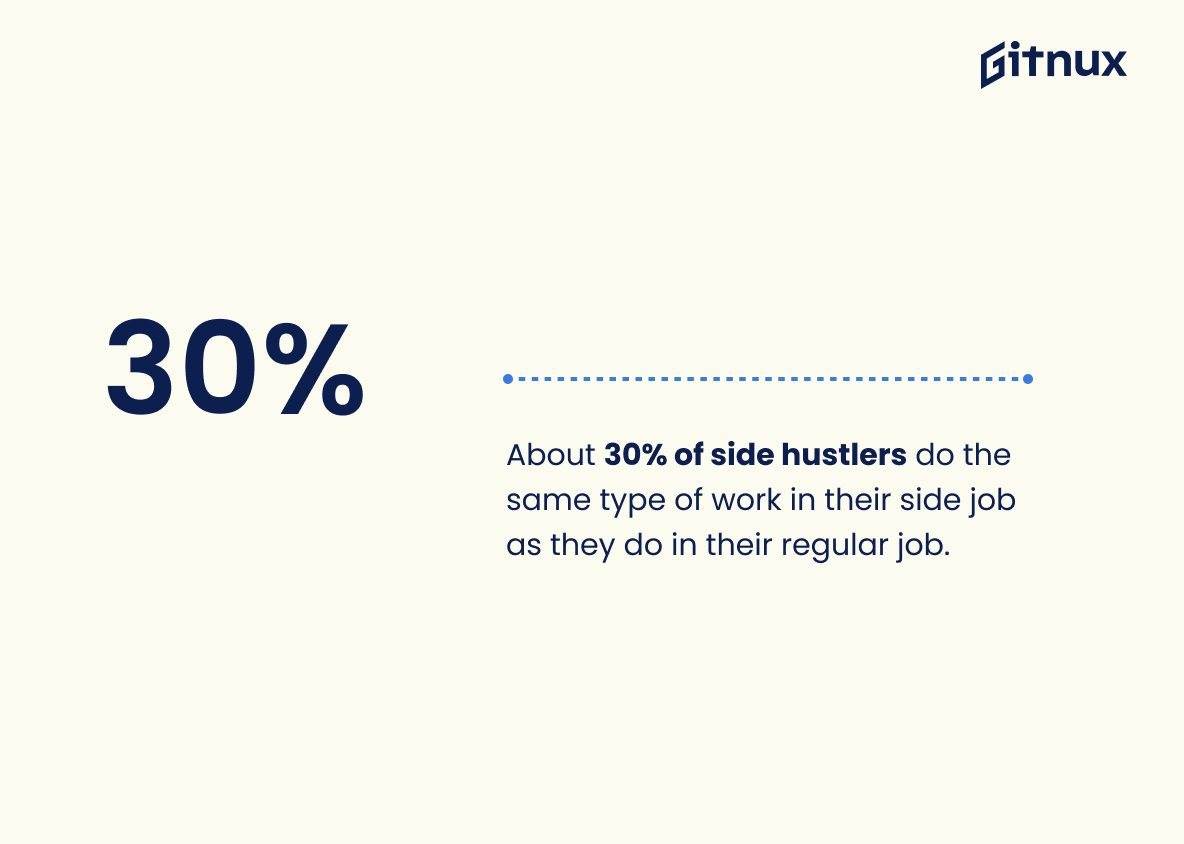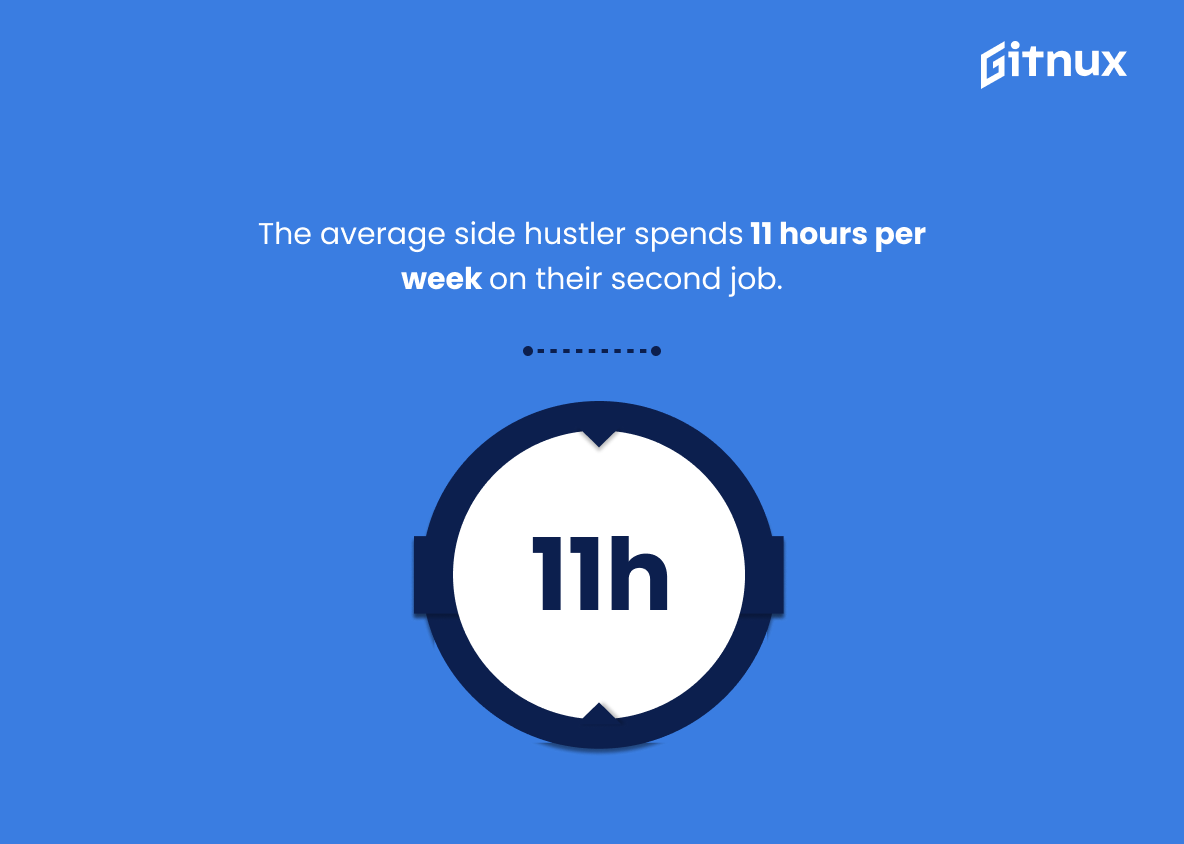As we embrace the digital age, having a traditional 9-to-5 job is no longer the only way to earn a living. More and more individuals are stepping into the dynamic world of side hustles, setting their entrepreneurial spirits free, and reaping the benefits of creativity and innovation. But what is the exact number of people diving into this trend? Are side hustles profitable enough to be considered a viable source of income?
This blog post will dissect the truths and trends behind the fascinating world of side hustles by diving deep into the most recent side hustle statistics. Brace yourselves as we unravel the facts and figures that are shaping the global economy, one side hustle at a time.
The Latest Side Hustle Statistics Unveiled
45% of working Americans report having a side hustle.
As readers navigate the roadmap of Side Hustle Statistics, the finding that a whopping 45% of working Americans report pursuing a side hustle serves as a towering milestone. This profound percentage underpins an emerging narrative of a diverse and industrious America, where a traditional nine-to-five job is continually being complemented by passionate after-hours endeavors.
This substantial proportion accentuates the burgeoning culture of entrepreneurship, assuring potential side hustlers that they’re joining a hearty and ever-growing club where moonlighting is the new norm. It’s not an isolated phenomenon, but a dynamic, national trend reflecting the evolving American work ethos. Ultimately, this figure paints a compelling portrait of side hustles transitioning from being merely optional to an ingrained part of the American employment fabric.
People can earn an average of $686 in additional income per month from a side hustle.
Highlighting the impressive figure of $686 in extra income from a side hustle beautifully underscores the financial possibilities that are ripe for exploration. Within the context of a blog post about Side Hustle Statistics, this nugget of data serves as a powerful motivator for readers considering initiating their own side venture.
It dramatically illustrates the significant earnings potential that lies beyond traditional employment, potentially alleviating financial stresses or supporting lifestyle upgrades. Ultimately, this monthly average income statistic is the hidden dollar sign in every side hustle’s success story.
1 in 4 millennials are partaking in the gig economy or side hustle trend.
The statistic, ‘1 in 4 millennials are partaking in the gig economy or side hustle trend’ serves as a potent catalyst for our understanding of the seismic shifts occurring within our contemporary workforce. Illuminated through these numeric evidence, millennials are indeed marching to a different rhythm, diverging from traditional employment routes to embrace the flexibility and autonomy offered by the gig economy.
With these insights, readers can discern the prevalence and momentum this trend holds among this demographic, pinpointing a transformative change in attitudes towards work-life balance, potential income streams, and entrepreneurship. Folded within this statistic, also lies a narrative of adaptation and innovation—traits commonly associated with millennials. As a result, this statistic adds significant weight to any discussion on side hustle trends, offering a pronouncedly clear picture of emerging socio-economic trends.
More than 36% of side hustlers make over $500 a month from their hustle.
This eye-catching statistic injects a sense of excitement and potential into the discussion on side hustles. The fact that over a third of individuals pursuing side gigs are making over $500 a month is offering a potential glimpse into the financial rewards that can be reaped. Not only does it underscore the viability of side hustles as supplementary income, but it also gives the ambitious an enticing benchmark to surpass.
The figures illuminate the side hustle landscape dramatically, fueling entrepreneurial spirit and supporting the narrative that the ‘gig economy’ is more than just a buzzword. It’s a growing sub-economy filled with viable opportunities for those willing to dip their toes in.
Over 50% of millennials have a side hustle because they say it brings them more financial security.
Spotlighting the statistic that more than half of millennials are engaging in side hustles for enhanced financial security underscores a resonant theme in the current economic climate. This trend sheds light on the shifting nature of labor markets and the desire for financial self-sufficiency among younger generations.
In the context of a blog post about Side Hustle Statistics, this data point dynamically illustrates the prevalence of side hustles among millennials, reflecting an entrepreneurial spirit paired with the need for financial resilience. Such a statistic can act as a centerpiece for exploring the motivations fueling the side hustle economy, offering a composite view of millennial striving and survival in a competitive, ever-changing economic landscape.
Men with side hustles earn 51% more than women with side jobs.
Delving into the intriguing realm of side hustle statistics, our eyes latch onto a stark revelation – men out-earn women by 51% in side jobs. An undeniable representation of the ongoing gender wage gap, this statistic doesn’t merely scream for attention, it demands investigation. Imagine the gravity of this revelation within the context of side hustles: on top of full-time jobs, individuals embark on these ventures to earn extra, save more, or fuel their passions. When the scales unbalance so heavily within this secondary income sphere, it provokes an intense conversation around inequity in remuneration.
The blog, whilst shedding light on various statistics, highlights this particular concern. Notably, as we unravel the world of side hustles, we’re also peeling back layers of societal bias laid out in stark numerical detail. Providing a portal into a larger dialogue, this statistic, and indeed the blog post, aligns perfectly with contemporary discourses around wage equality, reinforcing the need for systemic change.
38% of side hustlers consider their secondary work to be their true passion.
Delving into the realm of side hustles, the statistic asserting that ‘38% of side hustlers perceive their secondary work as their true passion’ paints an intriguing landscape. It implies that almost half of these entrepreneurs are pursuing their side hustles not merely for the additional revenue, but because they are genuinely impassioned by the work. This suggests a remarkable intersection between professional endeavors and personal satisfaction that drives these individuals to nimbly straddle two vocations simultaneously.
Consequently, this fact plays a pivotal role in reshaping our understanding of motivation factors in side hustle culture, highlighting personal fulfillment as a critical element alongside financial prospects. Results could echo across our blog post about Side Hustle Statistics, sparking readers to contemplate their own passions and potential entrepreneurial journeys.
About 30% of side hustlers do the same type of work in their side job as they do in their regular job.
Diving deep into the essence of the shared statistic, one can uncover an intriguing correlation. It appears that a significant chunk, around 30%, of side hustlers choose to tread familiar paths, opting for a side gig that mirrors their regular job. This translation of primary work skills into a secondary income option isn’t just a testament to the notion of skills transferability, but also showcases the potential for a passion-driven economy.
For up-and-coming entrepreneurs, this nugget of info can be a beacon – guiding them to leverage their existing expertise into diversified income, rather than venturing into unknown territories. And for businesses, it highlights an opportunity to tap into a pool of skilled freelancers who carry their primary job expertise into the gig marketplace. Now that’s a win-win, isn’t it?
People between the ages of 18 and 26 are most likely to have a side hustle.
“Diving into the heart of a vivacious demographic, the metric highlighting that individuals between 18 and 26 are most likely to have a side hustle offers a prism through which to view the economic landscape. In a blog post about side hustle statistics, this fact lights the pathway of exploration and analysis. It helps to illuminate the vigor and entrepreneurial spirit fervent in today’s youth.
Its essence showcases an economic trend among the younger generation, fueling their odds of juggling secondary jobs. Particularly, this statistic tells a tale of budding ambition, agility and unchartered potential, painting a more comprehensive portrait of the side hustle narrative.”
The average side hustler spends 11 hours per week on their second job.
Diving into the heart of our exploration on side hustle statistics, one cannot overlook the intriguing detail that the average side hustler devotes 11 hours per week to their second job. This nugget of information not only brings to life the tenacity and dedication fueling the side hustle economy, but it also shines a light on the time commitment individuals are willing to invest.
Imagine, these go-getters essentially add an additional workday to their week. This commitment of nearly a day and a half signifies the importance that people place on their side hustles, which could be driven by a range of factors, from financial necessity to the pursuit of passion. This tangible measure of time, therefore, carries weight as it encapsulates the essence of what it takes to sustain a side hustle, providing a silent yet powerful commentary on the endeavor’s immersive nature.
Nearly half of all side hustlers started their hustle to cover basic living expenses.
Delving into the pressing reality behind side hustles, the enlightening statistic that almost half of all side hustlers embark on their ventures to cater for basic living expenses uncovers profound societal implications. It underscores the extensive demographic grappling with economic constraints, pushing them to explore income diversification through side hustles.
Hence, in a blog post about Side Hustle Statistics, this piece of statistical insight contributes toward a holistic perspective, offering a comprehensive understanding of the root motivation driving people toward secondary professions or tasks. This insight serves as a crucial tool in illuminating areas where social or economic reform might be needed.
About 61% of side hustlers have considered turning it into their main job.
Delving into the world of side hustles, a standout figure emerges – a striking 61% of side hustlers contemplate converting their passion projects into a full-time career. This compelling metric not only reflects the growing entrepreneurial spirit globally, but also suggests that side hustles are far from just being casual hobbies or temporary fixes for financial crunches.
Rather, they hold the potential to evolve into impactful, income-generating ventures. As a result, this statistic continues to shape the narrative on side hustle trends, underlining a shift towards unconventional work structures and the pursuit of passion-driven careers. Crucially, it brings into focus the need for societies, governments, and businesses to adapt to this evolving work paradigm.
Among those who have a side hustle, 65% are looking to make more income.
Dive into the impressive chart of 65% people with side hustles seeking higher income. This nugget of data acts as a spotlight, illuminating the significant impact that side hustles have on individual financial goals. This numerical beam, not just entertains the readers with a substantial fact, but also marries perfectly with the theme of the blog, enriching their understanding of the financial motivation behind side hustles.
The percentage we aspire to emphasize underlines the depth of the side hustle culture, strongly hinting at its role as a supplementary income source, thereby enhancing the value of the content. This captivating statistic certainly paints a more comprehensive picture about the tenacity of those seeking supplemental income, fueling more engaging discussion and thought-provoking insights for the blog readers.
Those who earn money from a side hustle put in an average of 16 hours per week.
Peering into the fascinating data-drenched universe of side hustles, the statistic that notes entrepreneurs dedicating an average of 16 hours per week to their passion-driven profit avenues paints a vivid picture of commitment and effort. This nugget of data serves as a beacon, signaling not only the seriousness with which these ventures are undertaken but also offering a benchmark for prospective and newly minted side hustlers to gauge the time investment required.
It fluidly integrates an element of realism into the otherwise glamorized narrative of side hustles, emphasizing that success orbits around the gravitational force of hard, persistent work and the inescapable investment of time.
About 48% of Gen Zers make money from freelance work or side hustles.
Highlighting that nearly half of Gen Z individuals engage in freelance work or side gigs paints an illustrative snapshot of how the youngest working generation is reshaping the traditional employment landscape. This specific figure is particularly intriguing in a blog post dedicated to side hustle statistics, acting as a key indicator of trends in labor market flexibility, non-mainstream income streams, and Gen Z’s penchant for independence and entrepreneurship.
It evokes a deeper understanding of how this digitally savvy generation is leveraging their skills in the gig economy and can provide valuable insights for businesses, educators, and policy makers around the future of work.
Side hustlers comprise 37% of the American workforce.
In the vivid tapestry of the American workforce, an intriguing color has boldly made its mark – the side hustler. Representing a significant 37%, it’s a figure that cannot be overlooked. As we delve deeper into the world of Side Hustle Statistics, this striking proportion echoes the changing nuances of employment trends, speaks to the entrepreneurial spirit ingrained in the working population, and heralds the growth of this unique workforce demographic.
This data cascades insights on how American workers are embodying resourcefulness, embracing flexibility and leveraging their skills beyond their primary jobs. Therefore, it is an essential thread in our understanding of the complex pattern of the modern workforce landscape.
Only 15% of people who work a side gig do so out of financial necessity.
Peeling back the layers of this revealing 15% statistic uncovers a striking insight at the heart of the ‘side gig economy’. Contrary to popular belief, financial necessity isn’t the driving force for pursuing side hustles for the majority.
This flips the script over common perceptions, opening up a lively discussion on the motivations steering individuals towards the gig ecosystem. Thus, while dissecting this data, we find ourselves navigating an intriguing world where financial need takes a backseat, possibly replaced by the yearning for diversity, skill enhancement, or the sheer thrill of pursuing passion projects.
Conclusion
The world of side hustles has seen a remarkable growth in recent years, with more and more individuals taking on additional work outside their primary jobs. The statistics clearly reveal a shift in work culture shaped by economic need, skill diversification, or the pursuit of passion. Not only do side hustles contribute to the economy, but they also provide numerous benefits for individuals-ranging from financial security to personal fulfillment.
Staying updated with these statistics helps in understanding the trends and can provide valuable insights to navigate successfully in the growing arena of side hustles. So, whether you’re contemplating starting your own side gig, or merely aiming to understand this vibrant market, it’s undeniable that side hustles have become an essential part of our economy and lives.
References
0. – https://www.onovativebanking.com
1. – https://www.thisweekinworcester.com
2. – https://www.www.creativeboom.com
3. – https://www.www.flexjobs.com
4. – https://www.www.creditloan.com
5. – https://www.www.bankrate.com
6. – https://www.www.cnbc.com
7. – https://www.www.entrepreneur.com
8. – https://www.www.lendingtree.com
9. – https://www.www.gobankingrates.com
10. – https://www.www.finder.com
11. – https://www.kake.com
12. – https://www.journal.firsttuesday.us
13. – https://www.smartasset.com
14. – https://www.www.investopedia.com
15. – https://www.www.marketwatch.com
16. – https://www.www.fool.com


